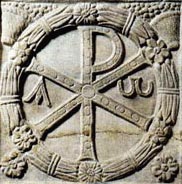Product Description
This finest collector-grade ancient Roman coin was minted under the rule of Constantius I, otherwise known as Constantius Chlorus. He was the father of one of the most famous and influential rulers of the Ancient World, Constantine the Great. As the father of Constantine, a number of Christian legends have grown up around Constantius. Eusebius's Life of Constantine claims that Constantius was himself, a Christian, although he pretended to be a pagan. While Caesar under Diocletian, he took no part in the Emperor's persecutions of the Christians. His first wife, Helena, claimed to find the True Cross.
This incredible coin is a large, silvered bronze follis coin and it displays the crispest and most ideal strike, detail and preservation! The coin is mounted in a handmade 14KT yellow gold beaded pendant setting. The display side shows a remarkable profile of Constantius with the reverse side showing Genius, standing and holding a patera and cornucopia. The ancient Roman idea of Genius was considered a spirit that helped all living things, similar to a guardian angel or spirit protector.
Certainly, one of the most impressive display pieces one could hope for using a genuine, ancient Roman coin. The silvering has given way to the warm, patinated bronze beneath, lacking any corrosion or degradation of the metal. This combination of colors really adds to the overall character of the coin!
ADD THE DISPLAYED THICK BEAD CHAIN
SEE MORE ANCIENT ROMAN COIN JEWELRY
 No event in the history of the Western world was probably more pivotal than that of the Christian conversion of the emperor Constantine. Constantine the Great, as he is famously known, was the first ruler of the Roman Empire to convert to Christianity. His conversion resulted from a miraculous event that took place on the battlefield. Constantine was encamped with his army at the Milvian Bridge, heavily outnumbered by the armies of his challenger Maxentius, across the river. The following historical account was recorded at that time by an ancient writer as follows:
No event in the history of the Western world was probably more pivotal than that of the Christian conversion of the emperor Constantine. Constantine the Great, as he is famously known, was the first ruler of the Roman Empire to convert to Christianity. His conversion resulted from a miraculous event that took place on the battlefield. Constantine was encamped with his army at the Milvian Bridge, heavily outnumbered by the armies of his challenger Maxentius, across the river. The following historical account was recorded at that time by an ancient writer as follows:
"Constantine was praying to his father's god, beseeching him to tell him who he was and imploring him to stretch out his right hand to help him in his present difficulties. While he was fervently praying, an incredible sign appeared to him from heaven. It would be hard to believe his account if it had been told by anyone else. But the victorious emperor long afterwards declared it to the writer of this history -- when I was honored to meet and talk with him and he even confirmed his statement by an oath. Thus, who could doubt him, especially since time has established its truth? He said that about noon, when the day was already beginning to decline, he saw with his own eyes the trophy of a cross of light in the heavens, above the sun, and an inscription that said 'Conquer by This' attached to it. Seeing this, he and his army, which followed him on an expedition and witnessed the miracle, were struck with amazement. He said that he doubted within himself what importance the vision might hold. He continued to ponder its meaning through until he fell asleep. While sleeping, the Christ of God appeared to him with the same sign he had seen earlier in the heavens. God commanded him to make a likeness of that sign which he had seen in the heavens and to use it as a safeguard in all encounters with his enemies."
Immediately, Constantine placed the sign of Christ on his standards and had it painted on his shields. Constantine won the day with a decisive victory and Maxentius, thrown from the Milvian Bridge, was drowned when the weight of his armor caused him to sink into the mud and ooze at the bottom of the River Tiber. His body was recovered the day after the battle. From this point on, Christianity became the official religion of the Empire and the capitol was moved from Rome to Constantinople (modern day Istanbul, Turkey).
Upon the death of Constantine the Great in 337 A.D., the Empire was divided among his three sons. The eldest son, Constantine II, took most of the Western Europe, the second son, Constantius II, received the entire Eastern Empire and the youngest Constans, ruled Italy and North Africa under the regency of Constantine II.
 US Dollars
US Dollars
 AUD
AUD
 CAD
CAD
 POUNDS STERLING
POUNDS STERLING






